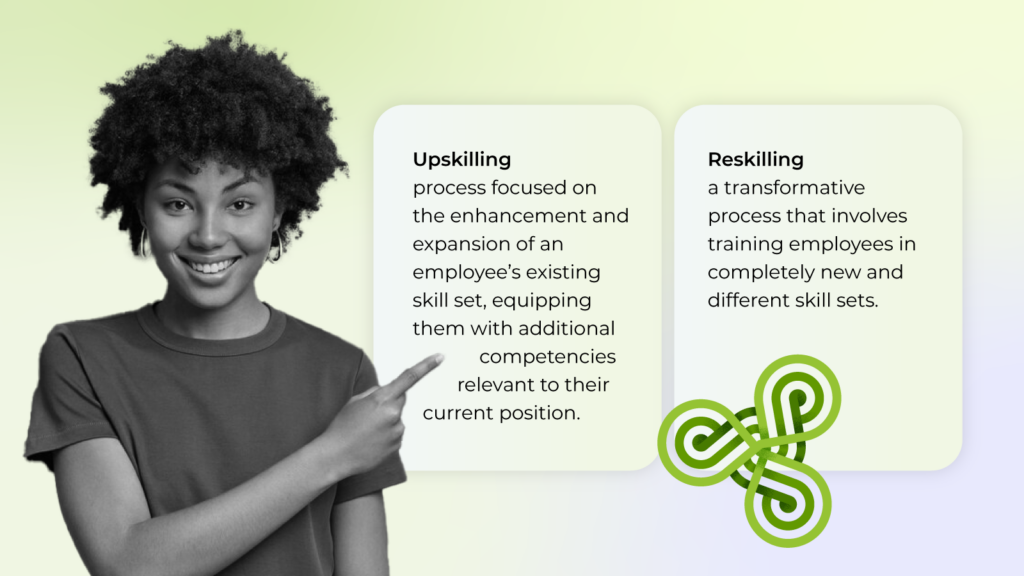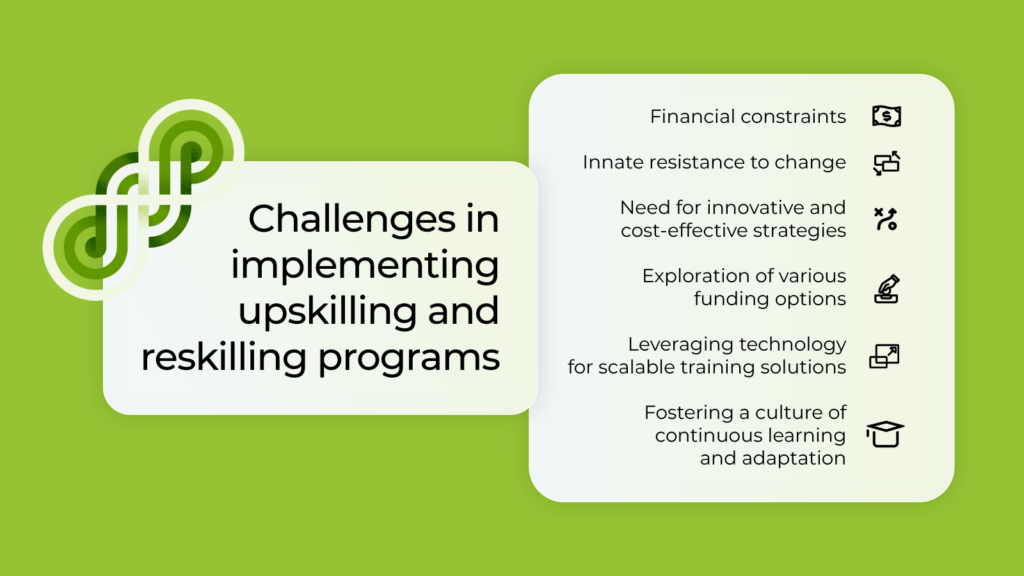The rise of upskilling and reskilling initiatives

The importance of future-proofing the workforce has emerged as a pivotal element of strategic business planning.
This concept focuses on equipping employees with the tools and knowledge they need to navigate and succeed in an increasingly dynamic job landscape.
It involves a proactive approach to workforce development, where the goal is to anticipate future trends and challenges, thereby ensuring that employees are not just prepared but are also proficient in skills that will be crucial soon.

This forward-thinking strategy is essential for businesses aiming to maintain a competitive edge and for employees striving to remain relevant and effective in their roles as the professional world continues to transform.
- The evolving job market
- What is upskilling?
- What is reskilling?
- The need for upskilling and reskilling
- Role of employers in upskilling and reskilling
- The role of governments and policy makers Government and policy maker’s role
- Challenges in implementing upskilling and reskilling programs
- Technological tools for upskilling and reskilling
- The impact of upskilling and reskilling on career progression
- Creating a learning culture in the workplace
- Measuring the success of upskilling and reskilling initiatives
- Global examples of upskilling and reskilling
- The future of work and continuous learning
- Conclusion
The evolving job market
The job landscape is in a constant state of flux, propelled by relentless technological progress and evolving demands across various industries. Key drivers of this transformation include the rapid advancement of automation and the integration of artificial intelligence into numerous work processes.
These developments are reshaping the very nature of work, creating a pressing need for a workforce that is not only adaptable but also proficient in emerging technologies.
To thrive in this changing environment, employees must continuously update their skills and knowledge, while businesses need to foster a culture that embraces these technological shifts.
This adaptation is crucial for keeping pace with the changing demands and ensuring that both individuals and organizations remain relevant and competitive in this new era of work.
What is upskilling?
Upskilling is the practice of equipping existing employees with new skills that align with the changing requirements of their current job roles.
This process is focused on enhancing and modernizing their skill sets to meet the evolving needs and expectations of their positions.
By undergoing upskilling, employees gain increased versatility and become more valuable assets in their current roles.

This approach not only keeps employees abreast of the latest industry trends and practices but also ensures that they remain integral and effective contributors to their organizations in an ever-changing work environment.
What is reskilling?
Reskilling, in contrast to upskilling, focuses on equipping employees with entirely new skill sets, preparing them to take on different roles within their organization.
This approach is distinct from upskilling, as it does not involve the enhancement of existing skills, but rather the acquisition of new ones.
Reskilling is a strategic response to shifts in job roles and responsibilities, enabling employees to adapt and transition to different areas of work that may be emerging or evolving within their company.
This process is crucial for maintaining a flexible and future-ready workforce, capable of meeting the diverse and changing needs of the organization in a dynamic business landscape.
The need for upskilling and reskilling
Considering the rapid rate at which job requirements are evolving, the practices of upskilling and reskilling have transitioned from being mere trends to becoming essential strategies for both employees and employers.
This necessity stems from the need to remain relevant and maintain a competitive edge in the ever-changing job market.
These approaches are crucial for adapting to new technologies, methodologies, and industry standards, ensuring that the workforce stays up-to-date and capable of meeting current and future demands.
For businesses, this investment in employee development is key to sustaining growth and innovation, while for employees, it’s vital for career longevity and success in an increasingly dynamic professional environment.
Role of employers in upskilling and reskilling
Employers are pivotal in driving the success of upskilling and reskilling initiatives.
These programs, when effectively implemented, offer dual benefits: they not only enhance the capabilities of employees but also significantly boost the organization’s overall growth and adaptability.
By investing in such educational and training programs, employers ensure that their workforce remains skilled, agile, and prepared to tackle current and future challenges. This investment is critical for fostering a culture of continuous learning and innovation within the organization, thereby maintaining a competitive edge in a rapidly evolving business landscape.
For businesses committed to long-term success, nurturing a workforce that is both knowledgeable and versatile through upskilling and reskilling is indispensable.
The role of governments and policy makers Government and policy maker’s role
Governments and policymakers hold a significant role in the realm of workforce development.
They can formulate policies and offer incentives that encourage businesses to invest in the upskilling and reskilling of their employees.
When these public entities collaborate with the private sector, it can substantially amplify the impact and effectiveness of these initiatives.
Such partnerships can lead to more comprehensive, well-supported programs that not only benefit individual organizations but also contribute to broader economic growth and skill development in the workforce at large.
These collaborative efforts between the public and private sectors are key to creating a more resilient and future-ready workforce.
Challenges in implementing upskilling and reskilling programs
Implementing upskilling and reskilling programs is not without its challenges. Key among these are financial constraints and the innate resistance to change that can be prevalent in organizations.
To successfully navigate these obstacles, organizations must devise innovative and cost-effective strategies.
This may involve exploring various funding options, leveraging technology for scalable training solutions, and fostering a culture that embraces continuous learning and adaptation.

By addressing these hurdles creatively and efficiently, organizations can ensure the effective rollout of these programs, thereby securing their long-term benefits for both employees and the organization as a whole.
Technological tools for upskilling and reskilling
Technological advancements have ushered in a variety of tools that significantly enhance the learning experience.
These include e-learning platforms and interactive training modules, which have revolutionized the way educational content is delivered and consumed.
These digital tools make learning more accessible, allowing employees to engage with training materials at their convenience and pace.
Additionally, the interactive nature of these modules makes the learning process more engaging and effective, catering to different learning styles and preferences.
This technological approach to learning not only facilitates a more flexible and inclusive training environment but also aligns with the modern workforce’s inclination towards digital and self-directed learning methods.
The impact of upskilling and reskilling on career progression
Employees who participate in upskilling and reskilling programs typically discover enhanced opportunities for career advancement.
These initiatives do more than just broaden their skill sets; they also substantially improve their job security and future career prospects.
By staying abreast of the latest skills and industry developments, employees increase their value within their current roles and become more attractive candidates for promotions or new opportunities.
In a job market that increasingly values adaptability and continuous learning, these programs equip employees with the tools they need to progress and succeed in their careers, ensuring they remain competitive and relevant in their fields.
Creating a learning culture in the workplace
Fostering a learning culture within an organization is pivotal in promoting continuous development and growth.
This culture is characterized by creating an environment where learning is not only valued but actively supported.
In such a setting, employees are encouraged to acquire new knowledge and skills, contributing to their personal and professional growth.
This emphasis on continuous learning leads to higher levels of employee engagement and productivity.
Employees feel more invested in their work and aligned with the company’s goals, driving both individual and organizational success.
A learning culture thus becomes a key driver in building a dynamic, innovative, and resilient workforce.
Measuring the success of upskilling and reskilling initiatives
The effectiveness of upskilling and reskilling programs can be evaluated through a range of metrics, such as improvements in employee performance, levels of engagement, and retention rates.
A positive return on investment (ROI) is a strong indicator of a successful initiative. These metrics provide tangible evidence of how these programs contribute to both individual and organizational growth.

Enhanced employee performance reflects the acquisition of new skills and competencies, while increased engagement and retention demonstrate a workforce that is both satisfied and committed to the organization.
A positive ROI, in turn, signifies that the benefits derived from these programs outweigh the costs, confirming their value and impact within the organization.
Global examples of upskilling and reskilling
Examining international case studies offers crucial insights into the effectiveness of different upskilling and reskilling strategies.
These examples from around the world highlight the varied methods that organizations and countries employ to bridge the skills gap.
By analyzing these case studies, one can understand the range of approaches and best practices in workforce development across different cultures and economic landscapes.
This global perspective not only sheds light on successful initiatives but also provides a broader understanding of how the skills gap is being addressed on a worldwide scale, offering valuable lessons and inspiration for organizations seeking to enhance their own workforce development strategies.
The future of work and continuous learning
The future of work is intrinsically linked to the concept of continuous learning.
As the job market undergoes rapid and constant evolution, the workforce must adapt accordingly. Keeping pace with these changes demands a strong commitment to ongoing education and skill development.

This continuous learning approach ensures that employees remain equipped with relevant skills and knowledge, enabling them to meet new challenges and seize emerging opportunities.
In a landscape where change is the only constant, the ability to learn and evolve becomes a critical factor for both individual and organizational success in the future world of work.
Conclusion
In conclusion, upskilling and reskilling emerge as crucial strategies for future-proofing the workforce in response to the rapidly evolving job market.
These approaches provide a vital pathway for both employees and organizations to adapt and thrive amidst the swift pace of change.
By embracing these strategies, businesses ensure their long-term success and sustainability, while employees secure their relevance and employability in the future workplace.
This commitment to continuous learning and development is fundamental in navigating the challenges of a dynamic professional landscape, positioning both individuals and organizations for enduring future success.
FAQs
What is the difference between reskilling and upskilling?
Upskilling is about enhancing existing skills for a current role, for example while reskilling is about learning new skills for a different role.
Why are upskilling and reskilling important for businesses?
They ensure the workforce remains skilled and adaptable, keeping the business competitive and relevant.
How can employers implement successful upskilling and reskilling programs?
By investing in learning resources, fostering a culture of continuous learning, and aligning training with business goals.
What role do governments play in workforce development?
Governments can create policies and incentives to keep talent and encourage businesses to invest in employee development.
How does upskilling and reskilling benefit employees?
They provide better job security, career advancement opportunities, and a broader skill set.
Share post